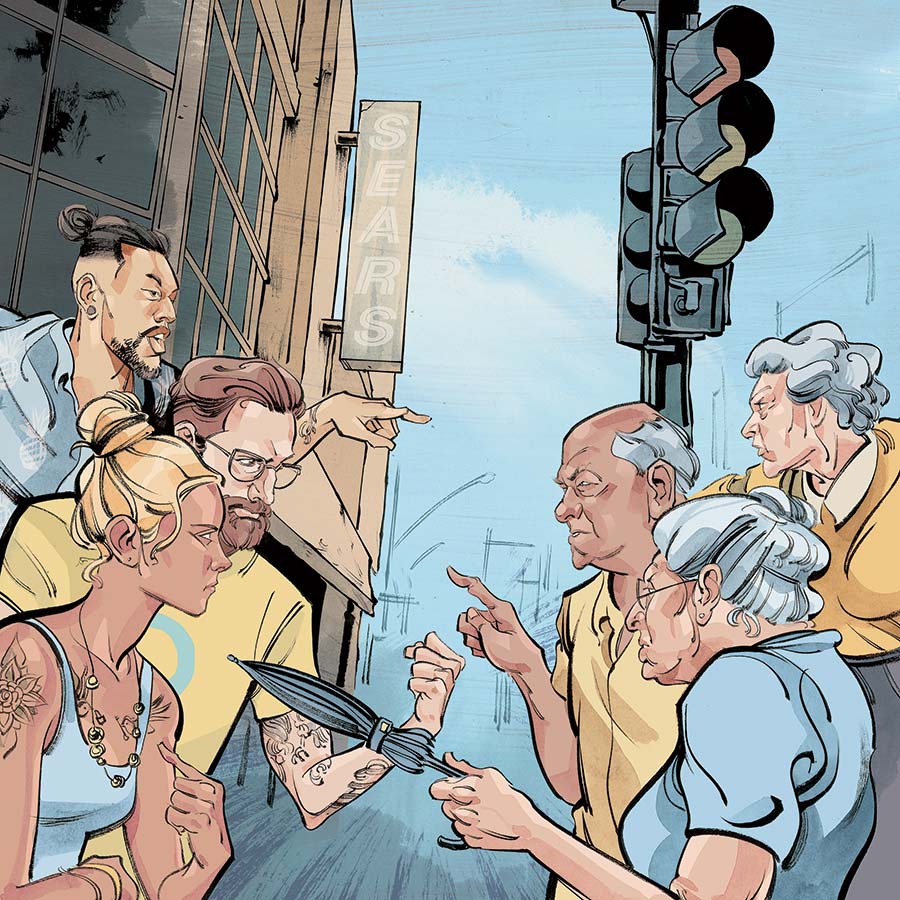
For most of its nearly 80-year existence, the Sears store at Six Corners established the district as a vibrant shopping hub, peddling everything a family could need or crave. These days, however, the Portage Park store — the last Sears in Chicago — is empty. It closed in mid-July, leaving a nearly square-block vacancy. The cavernous skeleton is just one of three major parcels that are or will soon be vacant at the intersection of Milwaukee Avenue, Cicero Avenue, and Irving Park Road on the city’s Northwest Side. Across the street, there’s a gaping three-acre triangle where a Bank of America branch once sat. Bordering that site is a six-acre Peoples Gas facility that’s scheduled to relocate.
A crippling blow to the local economy? Not exactly. Just ask the 45th Ward alderman, John Arena, who is positively giddy about the prospect of a once-in-a-generation restoration of the empty sites. “It’s an opportunity I never thought would come to fruition at one time,” he says.
Many envision a transformation into the next Logan Square or Andersonville, the streets sprinkled with boutiques and cafés. Families strolling to the park. Bikes and cars serenely sharing spacious byways. The beat of live music buzzing from concert venues.
So you can imagine their reaction when the area’s first proposed major redevelopment, slated for the bank parcel and backed by Arena, turned out to
be … a $120 million senior housing center. A neighborhood slugfest is brewing, one that pits young against old and trendy against traditional — a conflict that’s likely to play out again and again across the city as more old-school shopping districts fade into ghost towns. “This is a battle for the soul of Six Corners,” says Joe Angelastri, who owns the iconic City Newsstand and is “concerned” about the senior center proposal.
More than 400 people have signed an online petition against the development. “We want to see the site attract young professionals, people with disposable income, families with kids,” says Mark Johnson, 44, a West Loop property manager and resident of nearby Old Irving Park who started the opposition effort. “That would attract different stores and entertainment.” The petition states that its signees “support” senior housing in the neighborhood — just not on this site.
The proposed 10-story complex would have 265 upscale units renting for $4,400 to $7,200 a month, depending on the level of care. Representatives of Clark Street Real Estate and Minneapolis-based Ryan Companies, which are developing the site, told residents at a recent ward meeting that the apartments will be a mix of independent living, assisted living, and dementia units. The development would include an Aldi, a café, and green space. That, opponents say, means residents of the center wouldn’t have to venture into the neighborhood to eat or shop, further stifling foot traffic.
That may be so, but right now there’s not so much to do or buy around Six Corners anyway. Among the rundown buildings and empty storefronts, there’s a yogurt place, a few pubs, and a small theater, along with some chains. Then there’s the long-neglected Portage Theater, which has been out of the movie business for more than five years, though it sporadically hosted concerts until early this year. (The theater has a new owner, who declined to comment on his plans.)
Arena gets impatient with naysaying, particularly when it comes to the online petition. “I’ve heard over 300 people tell me we don’t want to be Wicker Park or Logan Square,” says the alderman. “I want to be the next best Portage Park, the best Six Corners.” The road to which, he says, is mapped out in a community-backed and city-sanctioned master plan. That’s a 2013 blueprint calling for five- or six-story projects mixed in with midsize retailers and smaller businesses — in other words, something similar to what the senior housing center would deliver.
A developer investing $120 million is a vote of confidence in Six Corners — it signals to other developers, business owners, and house hunters that it’s primed for future investment, the alderman asserts. He adds that new townhouses going up in the neighborhood, joining the existing older bungalows, are already attracting more people. The area is beginning to see a similar level of gentrification as its neighbors Albany Park and Irving Park. The median sale price for a single-family house in the primarily working-class enclave rose 11 percent, to $310,000, last year, according to Midwest Real Estate Data. Still, it remains a mecca for immigrants; nearly 42 percent of the residents are Latino, and it has one of the largest Polish populations in the city.
Developers of the senior complex hope to break ground by year-end — unless the project’s opponents find a way to stop it. Angelastri says some community members are organizing a push for an update to the 2013 master plan that squelches other big-ticket developments. What happens with the old bank parcel will likely influence the future of the hulking Sears property, which Arena expects will ultimately include residences and shops. Public meetings have yet to begin, but Seritage Growth Properties, a real estate investment firm that’s marketing many former Sears properties nationwide, and Highland Park–based Tucker Development are hashing out ideas.
In a May news release, the duo stressed they were looking “forward to working in close collaboration with the city and local stakeholders.” If the current fight is any indication, they’d better be ready for an earful.


